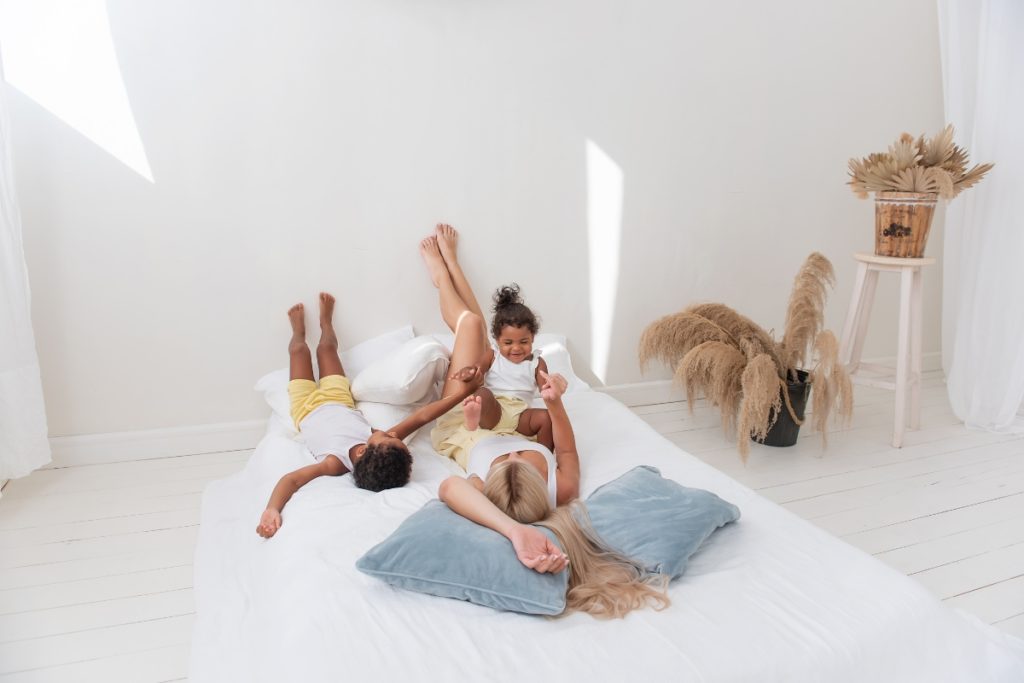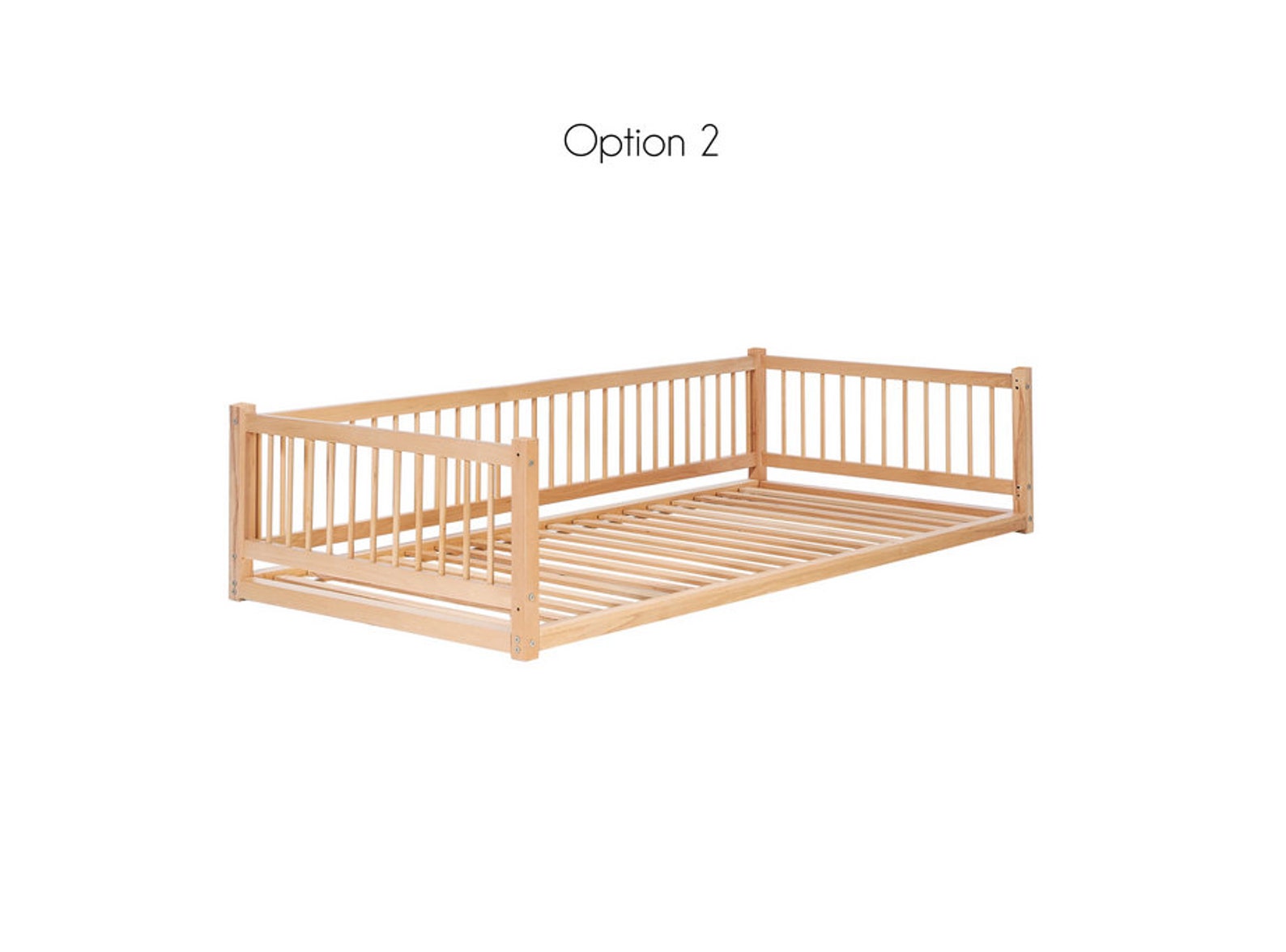Can you sleep on a mattress on the floor? Those on a budget, or moving are asking themselves that question.
Yes, you can put a mattress on the floor and hence why the concept of Montessori floor bed is rising. There are even some benefits to doing so, but you need to consider what the mattress is made of and your location.
Not all mattresses are designed to be placed on the floor. In fact, various mattress producers say that if you don’t use a base under it you could void the warranty, leaving you without any coverage.
The concept of sleeping directly on the floor isn’t new, it existed in Japan for years. However, the Japanese aren’t sleeping directly on the floor – they put tatami underneath.
It is common practice in Japan to sleep on a very thin mattress over a tatami mat, made of rice straw and woven with soft rush grass. Sleeping closer to the floor is another way to stay cool on an otherwise roasting, sweaty summer night in Japan.
Benefits of Sleeping on the Floor:
1. Relieves Back Pain
The floor is both a flat and hard surface. Placing a mattress on the floor ensures it’s sturdy and provides support for your spine. Proper spinal alignment plays an important role in sleep health, so it’s undeniably a great benefit. This helps maintain good posture and potentially reduces neck and back pain.
2. May Improve Posture
When sleeping on a mattress on a hard floor, your body is not less likely to sink into the mattress cushion. Much like sleeping on a hard foam mattress or an orthopedic mattress, your spine stays straight and your posture improves.
3. Improved Blood Circulation
Sleeping with your body in proper alignment allows your weight to be evenly distributed and reduces pressure caused by sleeping in unnatural positions. With less pressure, your blood floor is improved and your organs function more effectively.
4. Heat Relief
Cool air collects closer to the ground while hot air moves toward the ceiling. In the hot summer months, the cold draft of the floor might finally alleviate insomnia caused by hot sleeping and help you get some rest.
5. Helps Toddlers become more Independent
If you choose to use a floor bed instead of a crib for your toddler, you might receive some flack from other parents who think it’s unsafe. But as long as your room is baby-proofed, Montessori floor beds are extremely safe.
In fact, if you have the sort of curious two or three-year-olds that just might manage to climb over the rails of the crib and fall out, switch them to floor beds. They’re much safer! Your kids will have the chance to crawl around their room and crawl back into bed without needing to be consistently monitored.
The same goes for babies. You don’t have to worry about them rolling out of the crib. While breastfeeding, you can just lay there next to the child instead of carrying them. And you can save a lot on crib money as the mattress on the floor can be used for ten years or even longer.
So should you put your Mattress on the Floor?
Here are some important things to consider before putting your mattress on the floor:
1. Memory Foam Mattress Aren’t Meant to be Put on the Floor
Memory foam will create an almost watertight seal between the ground and the mattresses. The moisture underneath will not be able to breathe or evaporate, thus causing fungus and mold to develop. Yuck!
Even if you keep flipping the mattress it simply might be unavoidable, even if you have a dehumidifier in the room.
2. Risk of Moisture and Mold
In warm or humid places there’s a higher risk of mildew or mold when a mattress is placed on the floor. On the floor, that very airflow is drastically reduced.
Once a mattress is infested with mold and mildew, it’s nearly impossible to get rid of these fungi, and this is why manufacturers wave the warranty.
If you want to put a mattress on the floor find one with inner springs and flipping. An innerspring mattress is a good choice simply because it makes it easier for you to get up, while the dynamic movement relieves pressure points while increasing support.
3. You Might Get Cold
The cold air settles lower down while hot air rises. Just like the Japanese sleep on the floor to get cooler, you might be cold during the winter especially if a mattress is on a hardwood floor or concrete, which is common in rental apartments.
4. You’re Exposing Yourself To Dust On The Floor
You’re allergic to dust or pet hair? Putting a mattress on the floor makes you closer to the actual dust, especially in carpeted areas. You can vacuum up as much as you like but it does stay in there, even if you can’t see it with the naked eye.
The floor is home to all types of allergens, including pollen, dead skin cells, or even dust mites if you have pets. All of these allergens can trigger reactions such as runny noses, itchy skin and eyes, coughing, sneezing, and rashes.

How to Avoid Bad Outcomes from Putting a Mattress on the Floor
1. Get Low Railings and Slats
You can avoid a lot of issues by simply getting a few slats underneath. It won’t feel like the bed is raised, but it will limit the amount of moisture and allow easy entry and exit – especially if the bed is meant for toddlers. Here is one example.

2. Place a Mat Underneath
Carpet (removable and ideally washable) is not a bad thing if you are sleeping on the floor. It acts as a nice barrier between your mattress and the hard floor or ground. It allows more air to flow between the floor and mattress, and it’s warmer than a hard concrete or wood floor.
Another option is following the advice of the Japanese and buying a tatami mat. You can’t see it underneath the mattress so it won’t disturb your aesthetics, but it will solve the issues of moisture and cold breeze underneath.
3. Don’t do it if you have Health Conditions
If you’re someone who has mobility issues, arthritis or is grown in age, you might risk injury. If you have illnesses such as anemia, diabetes, or hypothyroidism; sleeping on the floor might not make you feel colder than normal. Even if you like the idea of spending time on the floor with your kids and grandkids, it’s best to check with your doctor before doing this.
4. Baby-proof your Room
If you have toddlers or babies, that shouldn’t stop you from sleeping on a mattress on the floor. In fact, there are many benefits to sleeping on the floor with young ones, as we’ve mentioned earlier.
5. Use Pillows for Support
While sleeping on the floor is good, you can’t use your regular pillow for this. Switch to a thinner pillow to avoid straining your neck.
While sleeping on your back or stomach is the ideal position, if you find you’re more likely to be sleeping on your side, you can also add extra pillows to support your knees.
It can take days, sometimes weeks to adjust to sleeping on the floor. Try doing it for a few hours at first so that your body adjusts. If you don’t like it you can always switch back to a traditional bed. But if you do like it, the benefits will speak for themselves!






Leave a reply